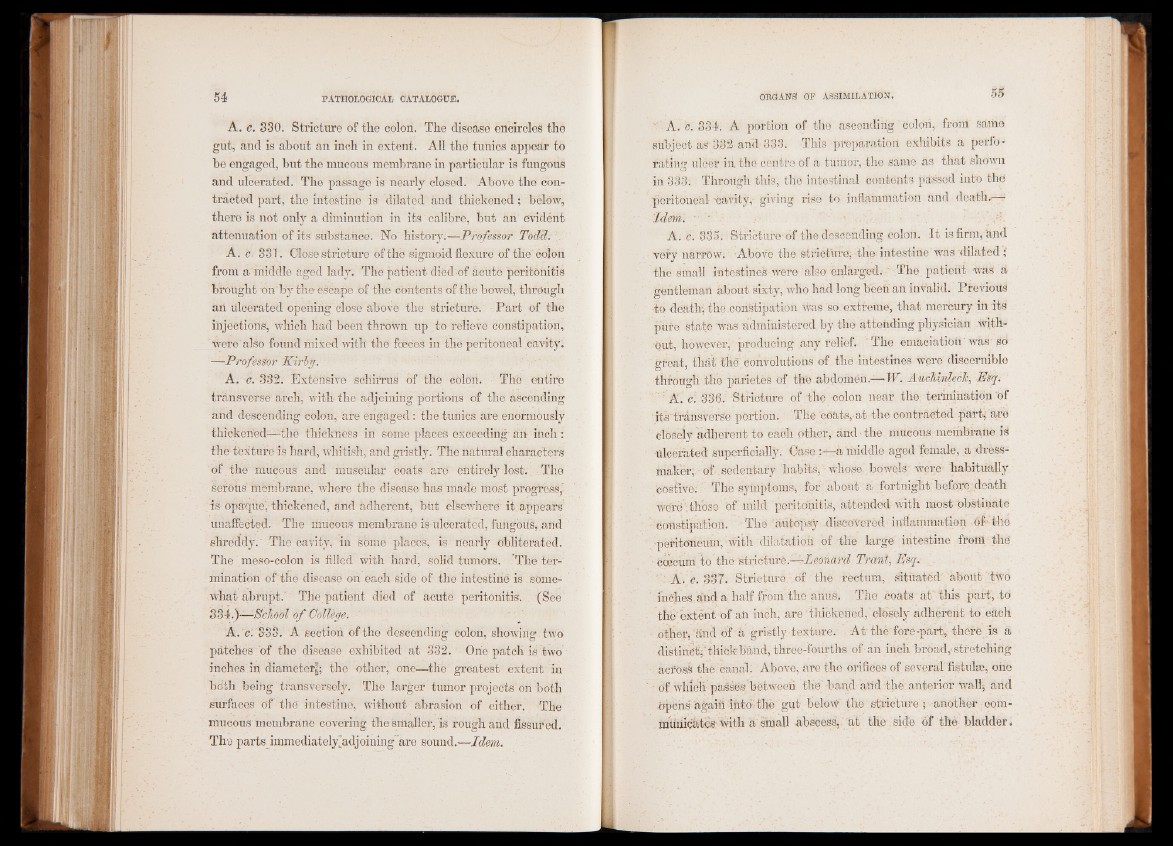
A. c. 330. Stricture of the colon. The disease encircles the
gut, and is about an inch in extent. All the tunics appear to
be engaged, but the mucous membrane in particular is fungous
and ulcerated. The passage is nearly closed. Above the contracted
part, the intestine is- dilated and thickened; below,
there is not only a diminution in its calibre, but an evidént
attenuation of its substance. No history.—Professor Todd: ;
A. c- 33.1. Close stricture of the sigmoid flexure of the 'colon
from a middle aged lady. The patient died of acute peritonitis
brought -on'by the-escape of the contents of the bowel, through
an ulcerated opening close above the stricture-. Part of the
injections, which had been thrown up to relieve constipation,
were'also found mixed with the fceces in the peritoneal cavity!
—Professor Kirby.
A, c. 332. Extensive schirrus óf the colon. Thé entire
transverse arch, with the adjoining portions of the ascending
and descending colon, are engaged: the tunics are enormously
thickened—Lthë thickness in some places exceeding an inch :
the texture is hard, whitish, and gristly. The natural characters
of the mucous and muscular coats 'are' entirely lost. - The
serous membrane, where the disease has made most progress,
is opaquè, thickened, and adherent, but elsewhere it;appears
unaffected. The mucous membrane is ulcerated, fungous, and
shreddy.' The cavity, in Some places, is nearly obliterated.
The meso-Colon is filled with hard, solid tumors. The tér- .
mination of the disease on each side of the intestine is somewhat
abrupt. The patient died of acute peritonitis. (See
331:.)—-School of College.
A. c. 333. A section of the descending colon, showing two
patches of the disease exhibited at 332. One patch is two
inches in diameter^; the other, one—the greatest extent in
both being transversely. The larger tumor projects on both
surfaces of thé intestine, without' abrasion of either. The
mucous membrane covering the smaller, is rough and fissured.
Tha parts immediately*adjoining~are sound.—Idem.
' A. e. 334<. A portion of the ascending colon, from same
subject as 382-and 833. This preparation exhibits a perforating
ulcer in. the centre of a tumor, the same as that shown
in 833: Through this, the intestinal contents passed into the
peritoneal -cavity,- giving rise to inflammation and death.-—■
Idem. • f
A. c. 83a; Stricture-of the,descending colon. It is firm, and
very narrow. Above the stricture, the intestitie' was dilated
the small intestines were also enlarged. The patient was a
gentleman about sixty, who had long been all invalid. Previous
to death, the constipation Was so extreme, that mercury in its
pure State was administered by the attending physician without,
however, producing any relief. The emaciation was-so
' great, that the convolutions of the intestines were discernible
through the parietes of the abdomën.—W. AucKirdecJc, Esq.
A. c. 336. Stricture of the -colon near the termination of
its'trUnsverSe portion. Thé coats,-at the contracted part, arc
’ closely adherent to each other,, and - the mucous membrane is
ulcerated superficially. Oase a middle aged female, a dressmaker,
of . sedentary habits, - whose bowels were habitually
costive. The symptoms, for about a fortnight before death
were ; those of mild peritonitis, attended with most obstinate
constipation. The autopsy- discovered inflammation óf- the
^peritoneum, with dilatation of the large intestine-from the"
- coecum to the stricture.-—-Leonard Trant, Esq.
A. c. 337. Stricture of the rectum, situated about two
inches and a half from the anus. The coats at' this part, to
the extent of all inch, are thickened,'closely adherent to each
other, and of a gristly texture. At the* fore -part, there is a
distinct; 'thick band, three-fourths of an inch broad,-stretching
across the canal. Above, are the orifices of several fistuke, one
of winch passes between the'hand and the: anterior wall, and
Opens again into the' gut below;' the stricture ; another oom-
munic'UtcV with a small abscess, at the.side of the bladder*